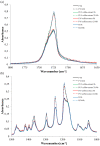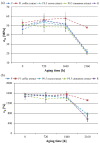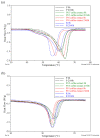Modification of Polycaprolactone with Plant Extracts to Improve the Aging Resistance
- PMID: 37512427
- PMCID: PMC10385144
- DOI: 10.3390/ma16145154
Modification of Polycaprolactone with Plant Extracts to Improve the Aging Resistance
Abstract
Natural extracts of plant origin are used as anti-aging compounds of biodegradable polymers. Coffee, cocoa, or cinnamon extracts in amounts from 0.5 to 10 wt.% were added to the polycaprolactone matrix. The manufactured materials were aged at elevated temperatures with increased relative humidity and continuous exposure to UV radiation for 720, 1440, or 2160 h. The performance of the proposed extracts was compared with the retail anti-aging compound, butylated hydroxytoluene. Visual assessment, FTIR analysis, melt flow rate, tensile strength, impact tensile strength, thermogravimetry, and differential scanning calorimetry tests were conducted. Results showed that the use of lower contents of the tested extracts is particularly advantageous. When the content of the extract did not exceed 1 wt.%, no unfavorable influence on the properties of the materials was observed. The stabilizing performance during accelerated aging was mostly similar to or greater than that of the reference compound used.
Keywords: accelerated aging; plant extracts; polycaprolactone; polyphenols.
Conflict of interest statement
The authors declare no conflict of interest.
Figures







References
-
- Vohlidal J. Polymer Degradation: A Short Review. Chem. Teach. Int. 2021;3:213–220. doi: 10.1515/cti-2020-0015. - DOI
-
- Kutz M. Handbook of Environmental Degradation of Materials. 3rd ed. Elsevier; Amsterdam, The Netherlands: 2018. pp. 1–684. - DOI
-
- Mierzwa-Hersztek M., Gondek K., Kopeć M. Degradation of Polyethylene and Biocomponent-Derived Polymer Materials: An Overview. J. Polym. Environ. 2019;27:600–611. doi: 10.1007/s10924-019-01368-4. - DOI
-
- Lichtenstein K., Lavoine N. Toward a Deeper Understanding of the Thermal Degradation Mechanism of Nanocellulose. Polym. Degrad. Stab. 2017;146:53–60. doi: 10.1016/j.polymdegradstab.2017.09.018. - DOI
-
- La Mantia F.P., Morreale M., Botta L., Mistretta M.C., Ceraulo M., Scaffaro R. Degradation of Polymer Blends: A Brief Review. Polym. Degrad. Stab. 2017;145:79–92. doi: 10.1016/j.polymdegradstab.2017.07.011. - DOI
Grants and funding
LinkOut - more resources
Full Text Sources

